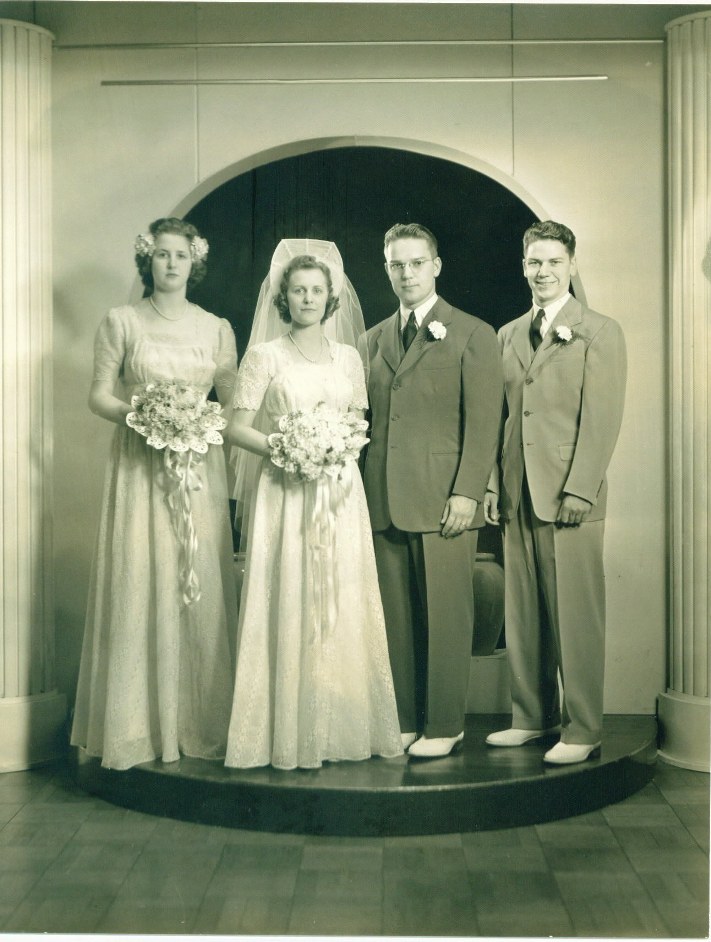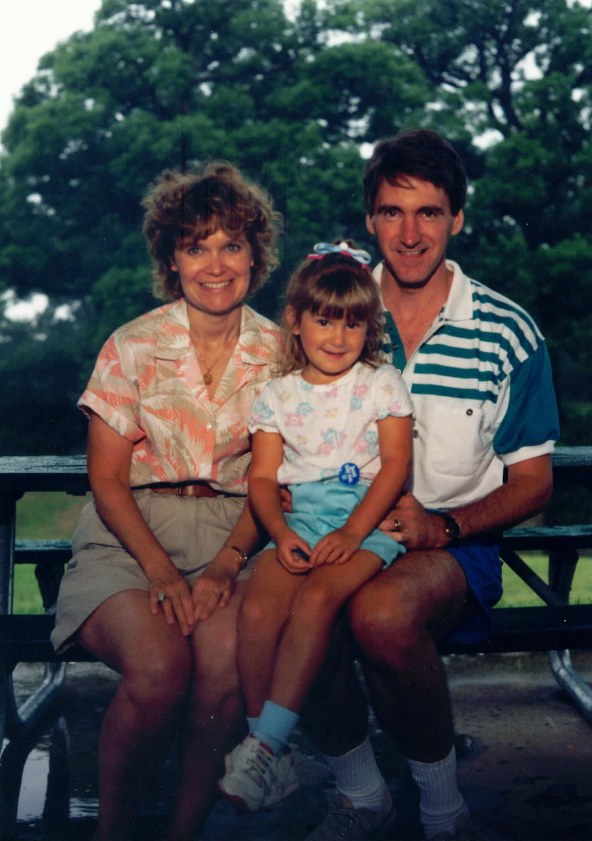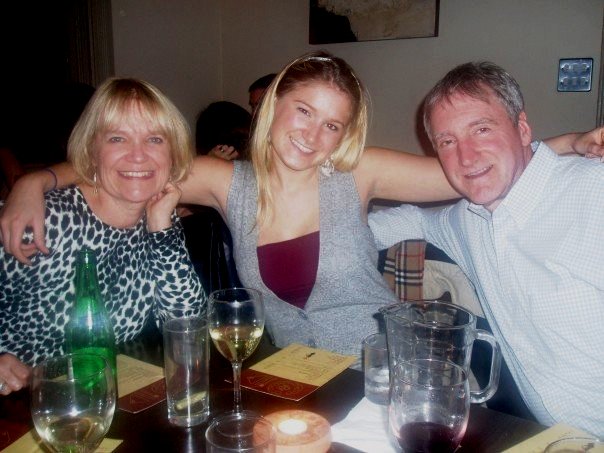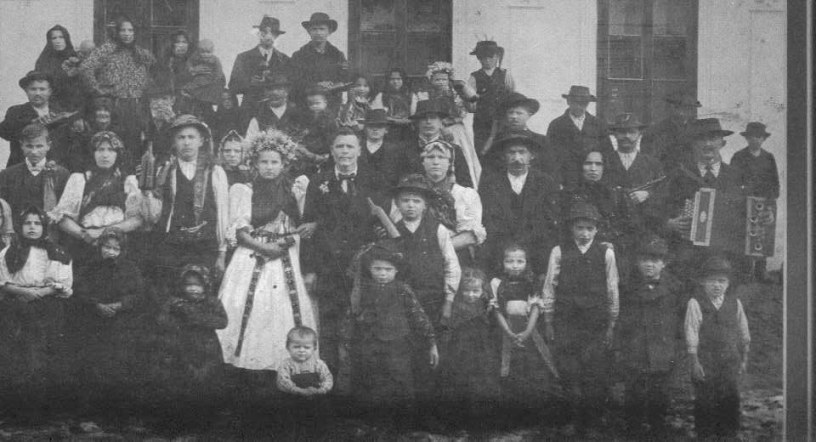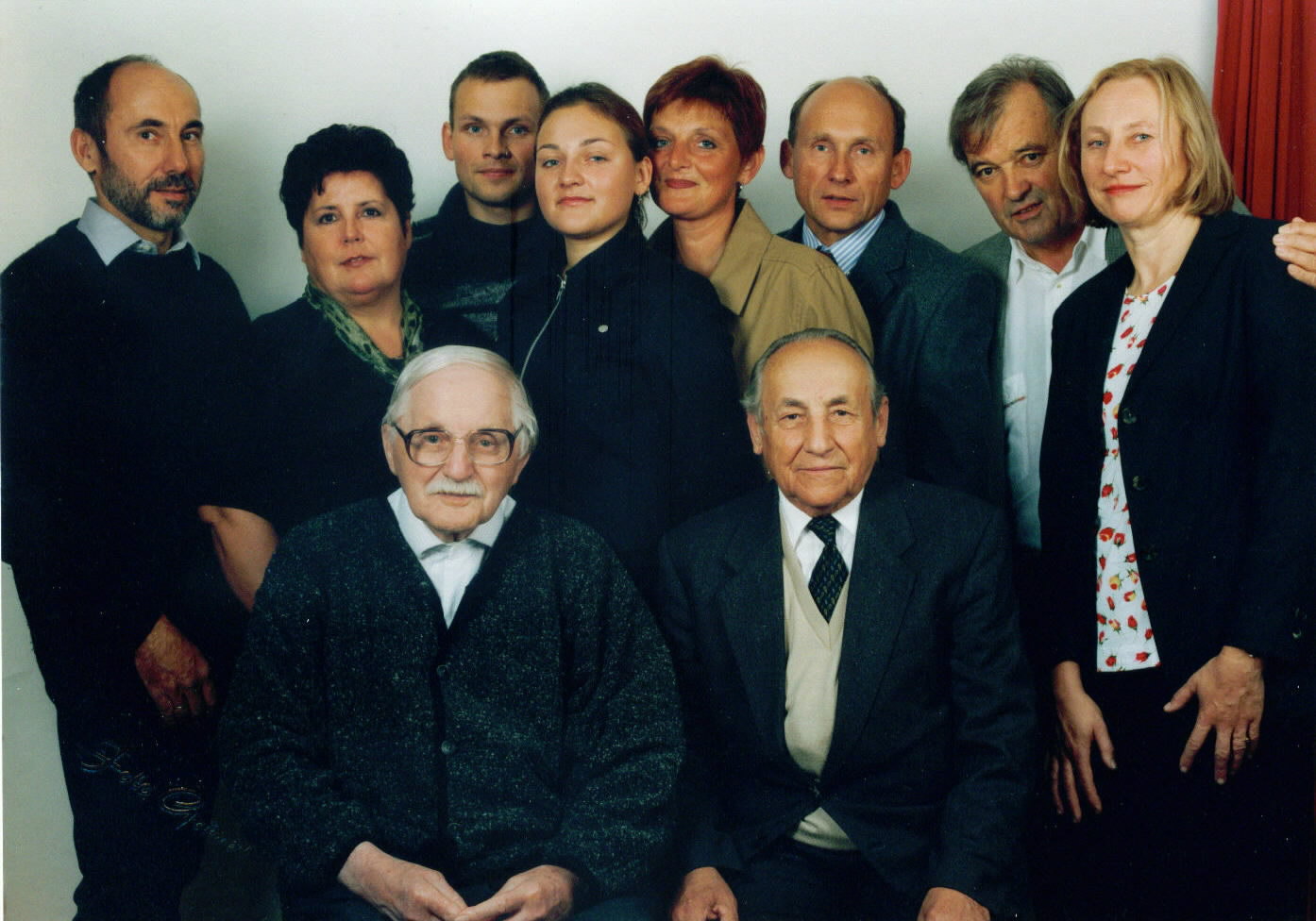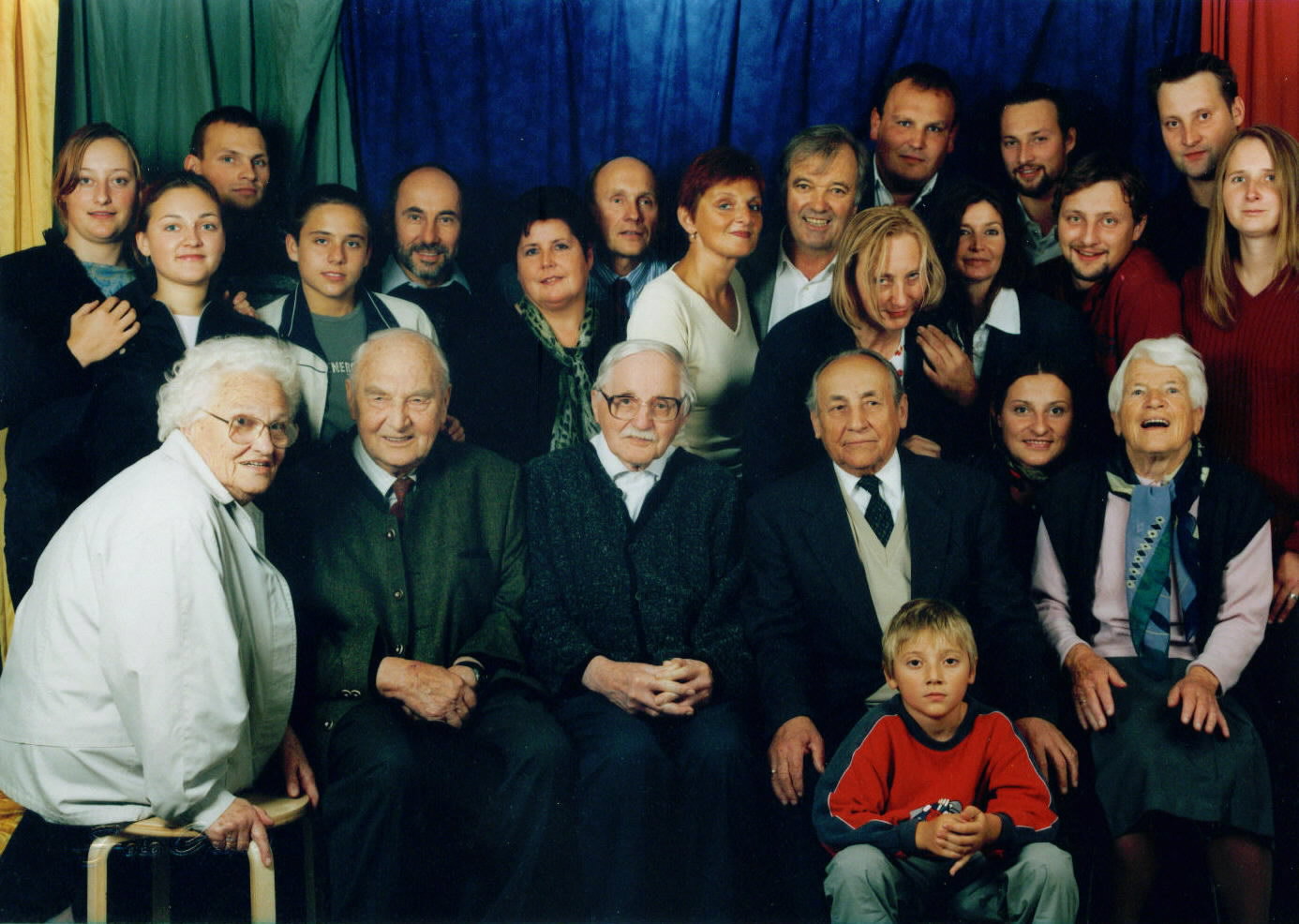Spouse Trees and Close Cousins

Navigate this page
| Labarge | Semon | Albums | Captain Joseph |
|---|
This page is dedicated to the family trees of the spouses of Morrisons between 1940 and today.
Dorothy LaBarge 1918 - 1998
Navigate the LaBarge page
| Pierre and Elsie | Dorothy and Keith | Fun Spot | Capt Joe LaBarge |
|---|---|---|---|
| Album Pictures | LaBarge Warnhoff Family | Ungawa Epic | Trilogy |
| Kids Talk | LaBarge Book 1985 | Lauck Family | Family Stories |
This section traces the family of Dorothy LaBarge
Dorothy and good friend Terza at a Michigan resort.
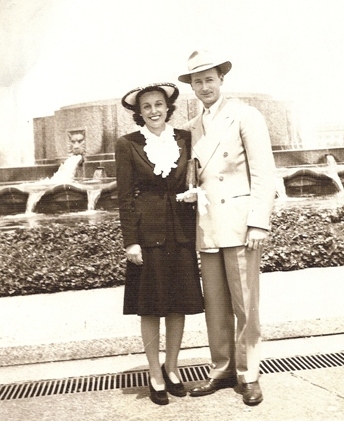
Dorothy and Keith celebrate their engagement in Washington, DC. 1943.
Honeymoon hotel in Kansas City. The Muehlebach Hotel is a hotel in Downtown Kansas City that was visited by every President from Theodore Roosevelt to Ronald Reagan. It was the White House headquarters for Harry S. Truman during his frequent visits to his home in nearby Independence, Missouri.This was probably one of the most expensive hotels in Kansas City.
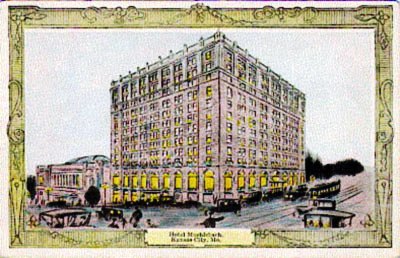
Truman stayed in Independence but conducted business in the Presidential suite in the penthouse. Truman predicted his upset victory to staffers at the hotel during election night 1948 (although he spent the night out of the media spotlight at the Elms Hotel in Excelsior Springs, Missouri).
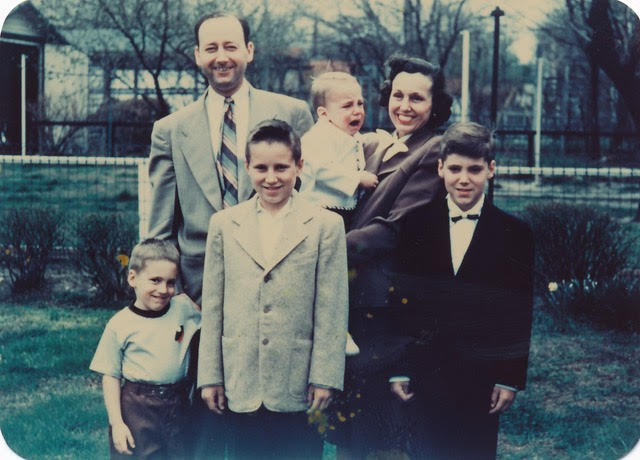
A family photo right after David was born.
This is a picture taken the summer of 1989. First row from the left is David (son#4), Keith, Patty (daughter), Dorothy, Denny (son#2). Top row Bill (son#5), Jim (son#3), and Tom (son#1).
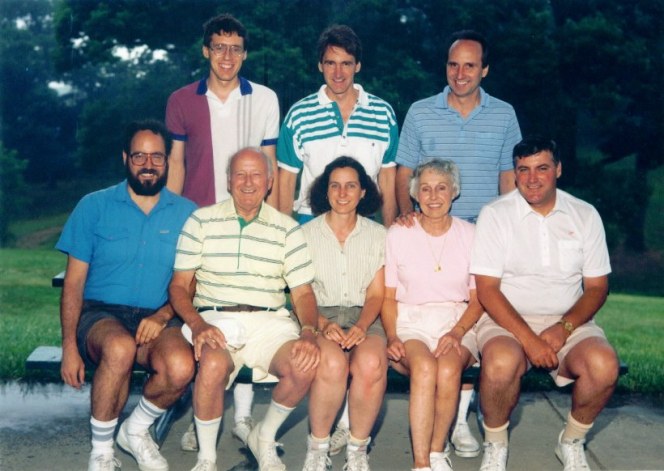
At the same picnic, a picture was taken of Keith and Dorothy with all the grandchildren. Only Alex, son of Pat and Jack Wilkes, is not present as he was born in November, 1989. First row Annie and Margie (daughters of Dave and Peggy Morrison), Lydia (daughter of Jim and Veronica Morrison), and Ben (son of Dave and Peggy). Back row are Jill and Curt, children of Denny and Terry Morrison.
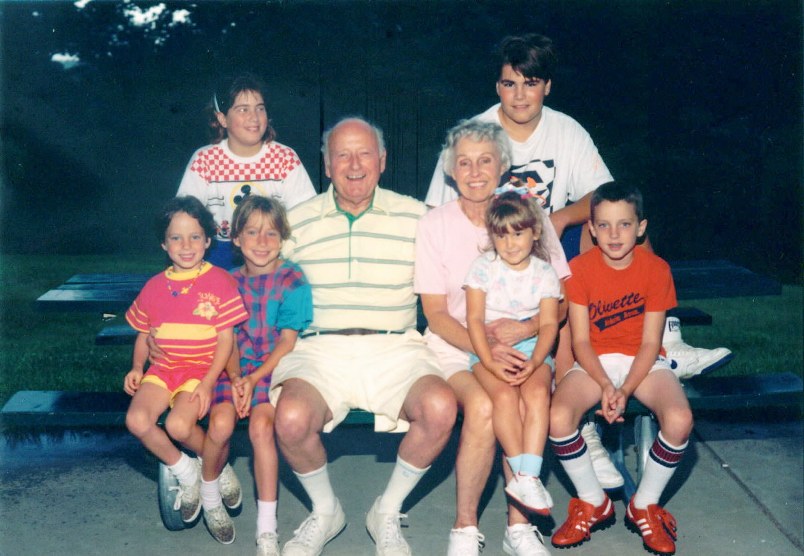
Dorothy died in 1998. At her wake, we celebrated her life and our family with the following stories.
Tornado 1927
Dorothy High School
Tom's story
Denny's story
Jim remembers the snacks
Patti's story
Bill and LMNO
Dorothy and our dinner feasts
The stories above make us laugh and make us wonder. How lucky we were to have such loving and caring parents. When Mom died, we realized how deeply Dad loved her and depended upon her companionship. Not that he didn't show it with all his kidding, and Mom giving it right back. But when she left us, Dad cried for months. It was a marriage made in heaven, both giving it the best they had. And raining down upon the children all the love they had for each other.
Keith was known for his little wisdoms. On one of his birthdays, Mary (Tom's wife) penned many of them on this parchment for our enjoyment.
Pierre and Elsie LaBarge
This section will focus on Pierre LaBarge born June 26, 1890. Pictures of parents and brothers are being added as they are found, as well as some close cousins.Pierre married Elsie Warnoff on October 4, 1915 when he was 25 years old. Elsie was 20. Here they are during courtin' time.
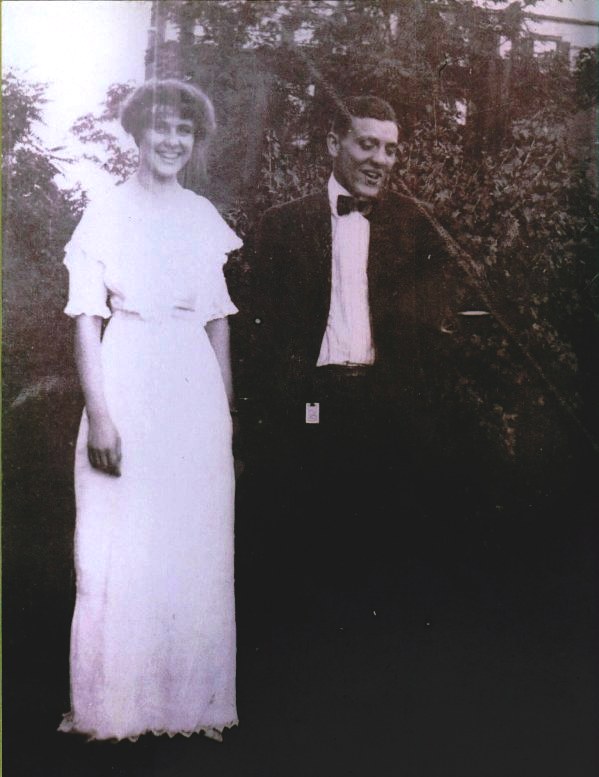
Here is a picture of their family around 1947 after the end of World War II.
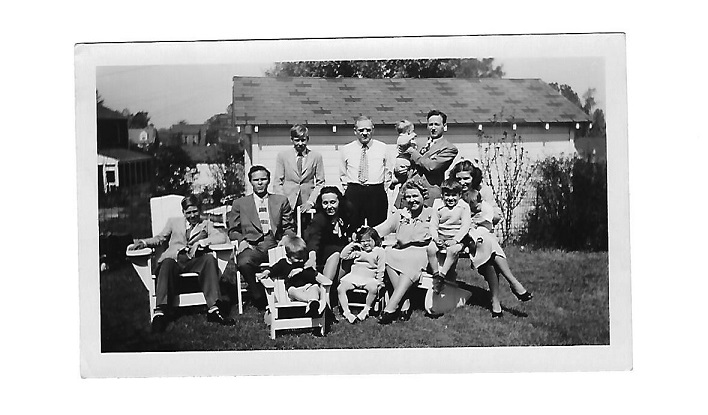
From left to right. First row: Gene (son), Pierre II (son), Tom Morrison (grandson), Dorothy Morrison (daughter), Susan Balducci (granddaughter), Elsie, Don Balducci (grandson), Virginia Balducci (Ginny - daughter).
Second row: Robert (son), Pierre, Denny Morrison (grandson), Keith Morrison (son-in-law).
In the second half of the 1970's, Tom and Mary and their son Kevin lived in Ghana while Tom worked for the US government as an economist. There were few trips back and forth from Africa, so cassette tapes became the means of staying in touch. This tape is special given that it was from Grandma Elsie and Grandpa Pierre who at the time were in there late seventies. Grandpa shows his sense of humor, by giving a solution to the flooding that was happening in Ghana at the time. Enjoy.
Audio: Tape to Tom and Mary in Ghana (wait for 7 seconds)
Dorothy was born Loulou Dorothy LaBarge, a fact not known to her children until after her death. Her birth certificate can be viewed in the Vital Records section. This is a picture of Dorothy's grandmother, Louise Thebeau Lauck, mother of Pierre LaBarge, who was known to her friends as Lulu, or Loulou as the case may be. The picture appears to be taken at a lavish ball.
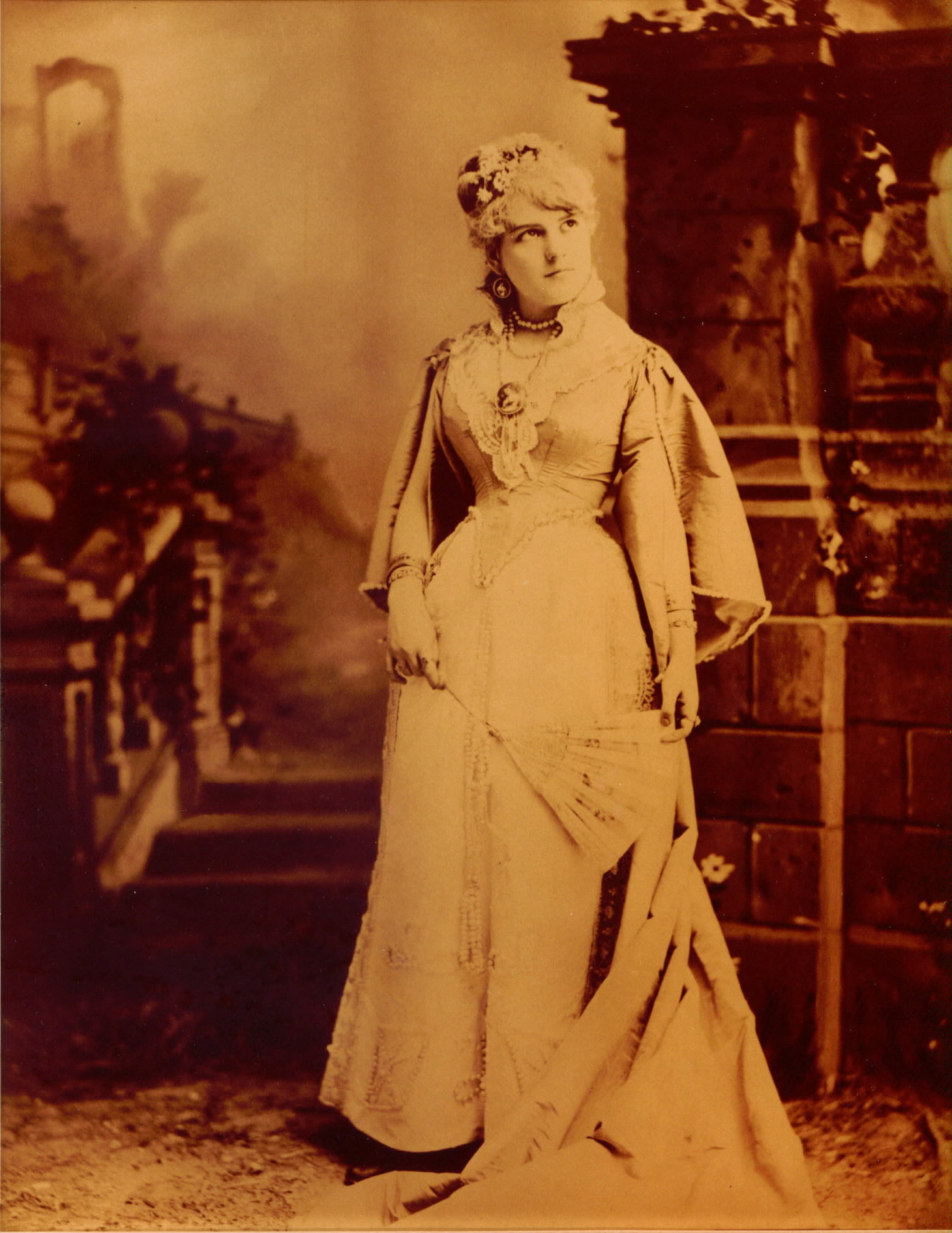
View the 1930 US Census for the family of Pierre L. LaBarge
Download Labarge Warnhoff Ged File
LaBarge Family Lines
by Lola Sorensen - AG 1985
A genealogy of the LaBarge family was commissioned by Pierre LaBarge in 1985. The professional genealogist was Lois Sorensen. This book traces the family back through France, and has many interesting stories of Captain Joe as well as documentation of how the family came through the fort at Kaskaskia, Illinois. This is a very thorough documentation of what was known pre-internet age, and has stood the test of time. The chapters are broken down to allow faster downloading.
Title and Contents
This file is the title page and contents of the book, as well as a preface by the author.
Summary Pedigree
This file shows four pages of the summary trees at the front of the book.
Chapter 1 Labarge
This is the first chapter which describes the LaBarge family as they made their way from French Canada to St. Louis. Many references to Captain Joe, the famous riverboat captain.
Chapter 1 Labarge Sheets
This shows the family sheet of the LaBarges in Chapter 1.
Chapter 2 Eliza Hortiz
This discusses the family of Eulalie Hortiz, wife of Joseph Marie LaBarge. Also discussed is Jean Baptiste Nicolas Bequet, master locksmith of Paris who came to Fort Kaskaskia.
Chapter 2 Hortiz Bequet Sheets
This shows the family sheets referenced in Chapter 2.
Chapter 3 Eliza Gueret
This discusses the family of Eliza Gueret, wife of Joseph LaBarge, Jr.. Other family names include Dumont.
Chapter 3 Gueret Dumont Sheets
This shows the family sheets referenced in Chapter 3.
Chapter 4 Louisa Lauck
This discusses the family of Louisa Lauck, wife of Henry Septime LaBarge. The Lauck family has an interesting history of serving in the Revolutionary War, and as famous rifle makers. Also, Amelia Heiskell's quilts are some of the most treasured pre Civil War pieces in the DAR Museum in DC, and the museum of Williamsburg.
Chapter 4 Lauck Heiskell Lindsey Ham Sheets
This shows the family sheets referenced in Chapter 4.
Chapter 5 Elsie Warnoff
This discusses the family of Elsie Warnoff, wife of Pierre LaBarge, Sr.. The Warnoff family came from Prussia, which is now Poland, around 1850.
Chapter 5 Warnoff Sheets
This shows the family sheets referenced in Chapter 5.
Documents and letters of the Lauck family
Pension records, etc.
Documents and letters of the Lindsey family
Letters from John Lindsey, etc.
The full Labarge family in 1966. Bob, Ginny, Pierre, Elsie, Gene, Dot, and Pierre Jr.
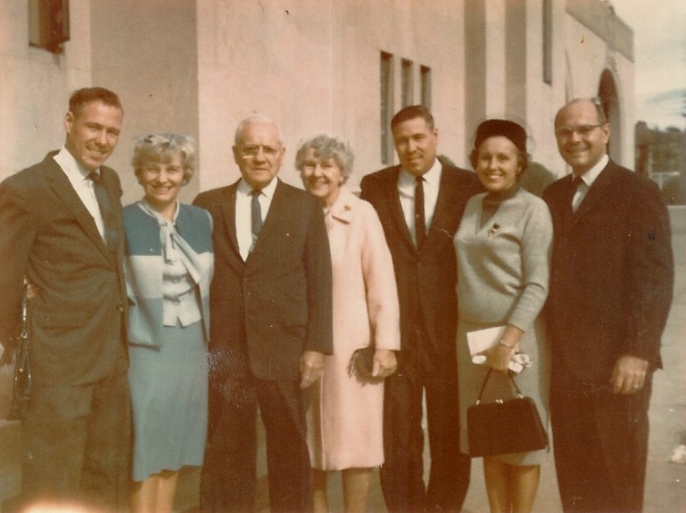
Every holiday was spent on Neosho in south St. Louis at Grandman and Grandpa's. What a hoot!. The cousins had reign of the house (except for their bedroom which was off limits!). Board games, cards, and a visit to the basement to see Bob and Gene's paintings on the cement walls of the jets they flew . Must have been 15 cousins with their parents. The following are pictures of the music box which we constantly were taking apart to see how it worked. Play the tune, and it will take you back to those days.
The Morrison family at Keith and Dorothy's 50th wedding anniversary in 1993. From the left back row: Jack and Patti Wilkes with son Alex, son Kevin with Mary and Tom, skip Dave, daughter Jill son Curt with Denny and Terry, Jim and Veronica with daughter Lydia, Kathy and Bill. Front row from left: Doctor Ben with Peggy and Dave with daughters Annie and Margie, Keith and Dorothy. Everyone simply gorgeous!
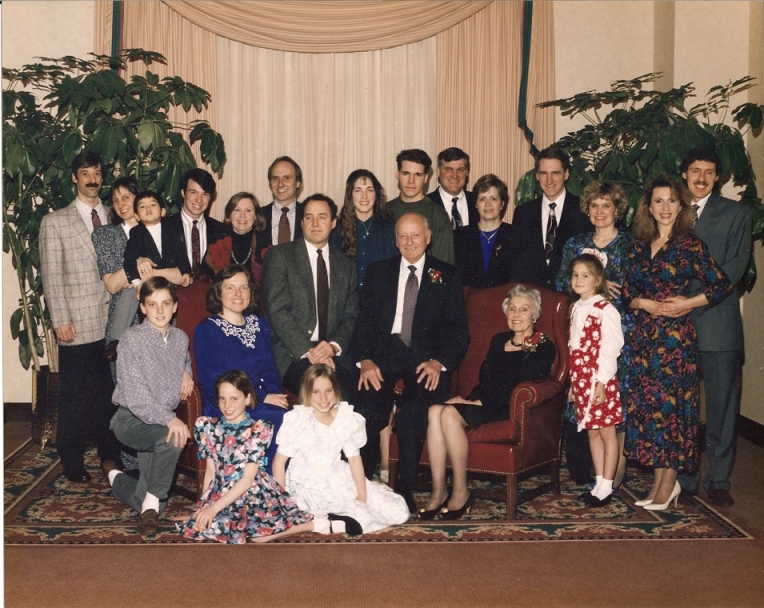
Pierre was a professional baseball player as a catcher. This is a picture of him around 1915. Following in his footsteps were his grandsons, Jim and Dave, Tom, and great grandson Kevin.
And let's not forget about Keith, who pitched a no-hit softball game!
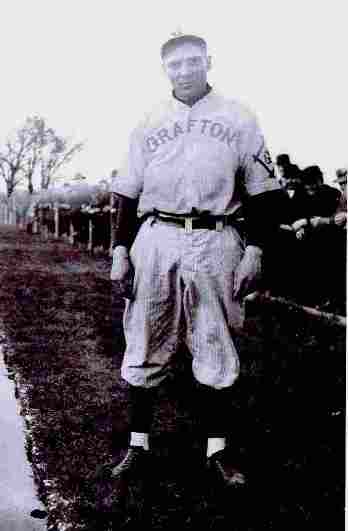
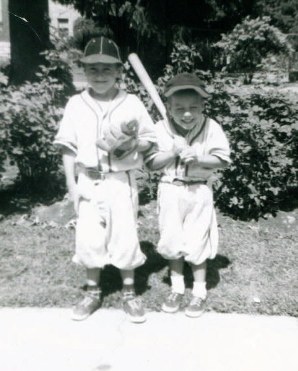
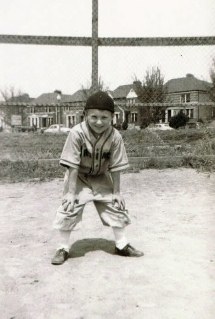
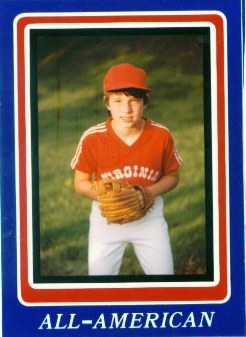
Following are important pictures of the formative years of each sibling.
Bill the Great
Dave's Gang
XMAS Gifts
Nobody's going to rob this house. Protected by Jim and Dave with the firepower, Tom with the hockey stick, Denny at tackle, and Patty with the killer dolly. Oh, and don't let Dad get to singing with the accordion.
Go Kart Contest: Which brothers had the best?
Jim and Dave's go-mobile. Forerunner of the Humvee. Seats eight. When retired can be used as a clubhouse. Wingspan larger than a Mac Truck. Has been clocked on Crash Hill at 40 MPH. Unfortunately, no brakes can stop it. David learned forward momentum the hard way when he jumped off the back. Jim is the driver, and Dave has taken Bill hostage for the ride of his life. Note, we were not spelling bee champions (see roof and name Sqeaky).
"I know what you're thinkin' punk. Did I shoot off six caps or five caps. Go ahead. Make my day."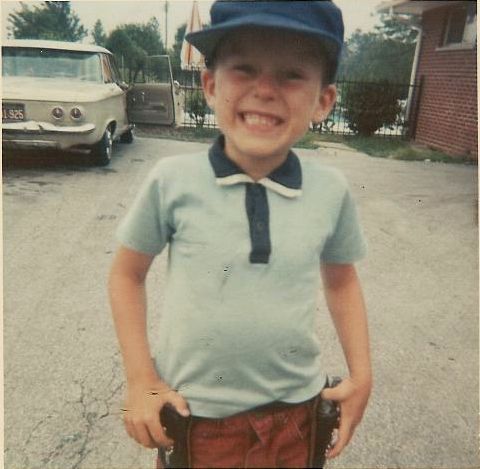
"Yeah,name's Mugsy. This is my gang, see. Tommy the Jacket. Big Hair Denny. And Itchy Fingers Jimmy. Make a move and you'll be sorry, see. "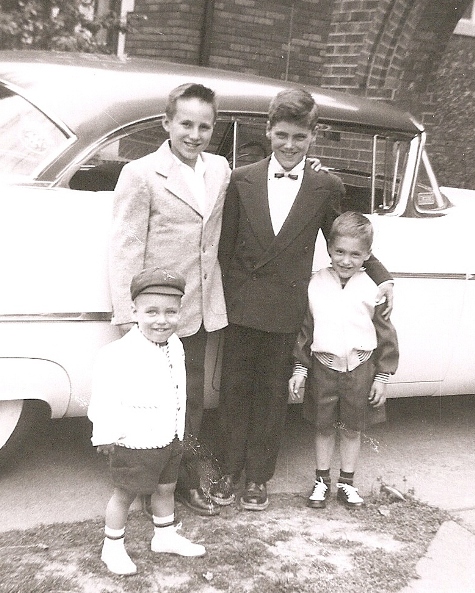
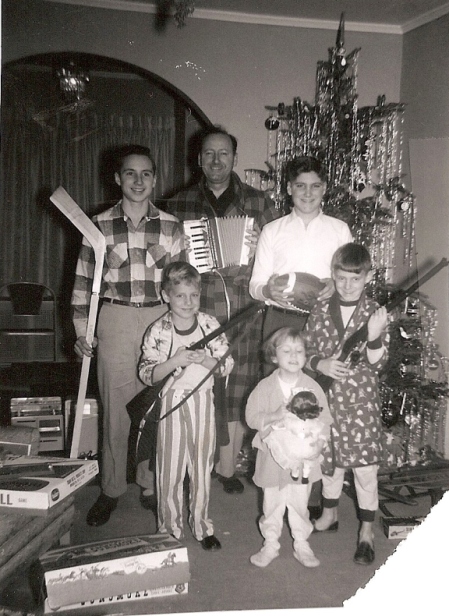
That's silver tinsel on the tree. Do they still sell that? "I see an ornament that's black and white and grey and charcoal and dark grey...". Patty, what are you saying to your Dolly? Has she been bad? See the toys in the background? Play stove for Patty. Who can decipher the words on the box with the cowboys? Love Patty's slippers. And those are authentic Chuck Connor's Rifleman rifles!
Tom and friends St. Stephen's parade go-kart. A real sleek and fast vehicle. Gets infinity miles to the gallon. Four kid power and room for one.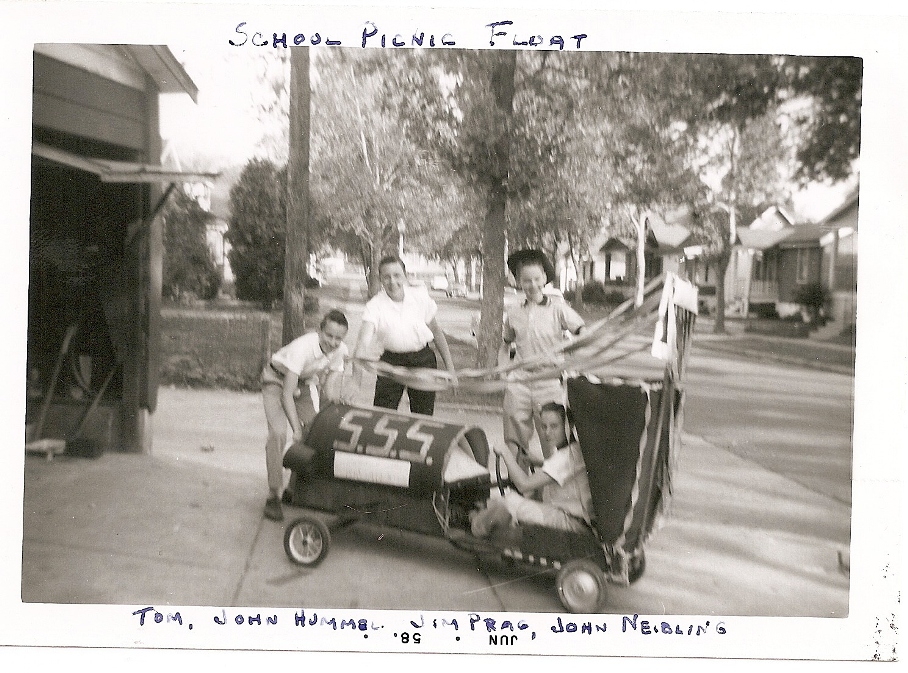
Tom notes.
It did have a motor, which I was cranking up in the photo. The guy standing next to me, John Hummel (his father was owner of Hummels Market in the neighborhood), was very handy and he rigged a lawn mower motor so it would work on the go-cart. The problem was it vibrated the go-cart so much that the whole thing was falling apart by the end of the parade. But the 8th grade girls all felt sorry for us and gave us lots of sympathy, which we accepted.
Tom
"SQEAKY RULES."
By the way, I know for a fact that Sqeaky was the first production go kart that had pencil holders, which was the forerunner of all sorts of extras now found as standard equipment on the best selling autos."
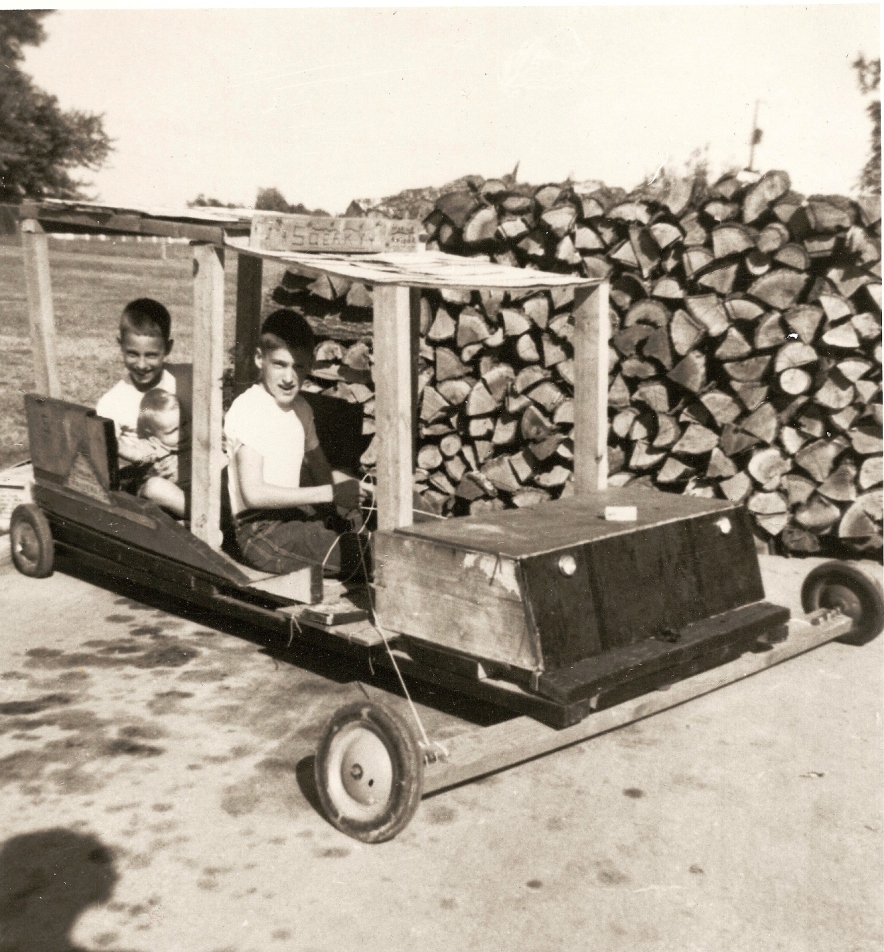
Picture Albums
LaBarge Family 1910 to 1940: Roaring and Tough Times
Dot and Keith Morrison: Love and War Times
Tom born May 1, 1944: Family Times
Denny born June 11, 1946: Good times 1946 - 1950.
Jim born February 8, 1951: The Best of Times 1951-1953.
Dave born August 8, 1953: Silly Times 1953-1955.
Patty born October 2, 1955: Little Girl Times 1955-1959.
Captain Joseph Marie LaBarge Jr.
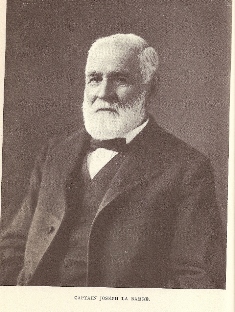 Biography of Captain Joseph LaBarge
Biography of Captain Joseph LaBargeLegendary Riverboat Captain
It was reported in a newspaper article that Captain LaBarge was the man who taught Mark Twain about life on the Mississippi. No other man was more respected as a captain of riverboat steamers than he. His wife was the first white woman seen by the Sioux tribes.
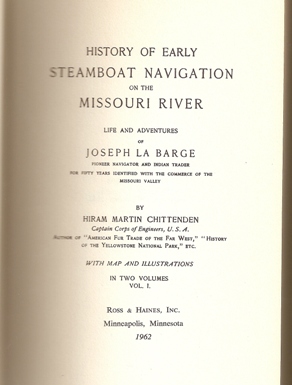
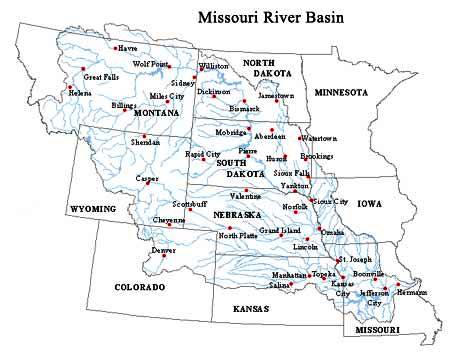
In the summer of 1896, Hiram Martin Chittenden, noted historian and author of the early west, undertook a project that would produce two volumes of work covering the history of steamboat navigation on the Missouri River from 1830 to 1880. The subject, and from whom much of the work was based on, was the venerable Missouri River Pilot, Captain Joseph La Barge. In his home in St. Louis, the Captain recounted his days on the river, and with clear memory and accuracy laid out the stories for the author. Many copies of this book are in the hands of his descendants, still living and prospering in the city of St. Louis. The many adventures with the Indians, the Generals of the Union Army, and other famous people render the book an enjoyable read.
Historic Missourians - State Historical Society of Missouri
Life of Captain Joseph LaBarge - More stories
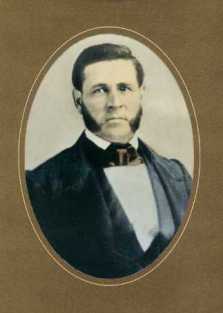
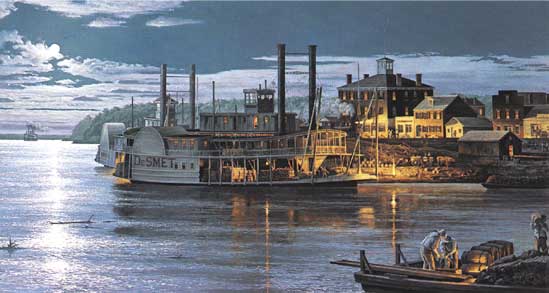
Steamboat Desmet built by Joseph Labarge: Prints for Sale on the Web
National Mississippi River Musuem Dubuque Iowa
Captain Joseph LaBarge has been inducted into the Museum's Hall of Fame for Riverboat captains.
Here is a five page magazine article about Captain Joseph Labarge printed in the 1973 Yearbook of "Best of the West". The article was written by Joe Koller and was entitled "Pilot on the River of Hazards".
The American West September, 1970, issue feature story was a six page article titled "Steamboat to the Rockies". While much of the article drew upon the two volume book on Captain Joseph LaBarge by H. M. Chittenden, it is an exciting story of navigation on the Missouri.
This site is dedicated to the preservation of steamboat history. Many old photographs, links.
Famous painting: Source of the Missouri
Following are pictures of the scenic Missouri River as it winds through Montana. The first picture shows "Labarge Rock", named for Captain Joe, directly across from Eagle encampment where Lewis and Clark stayed on March 31, 1805 on their historic expidition.
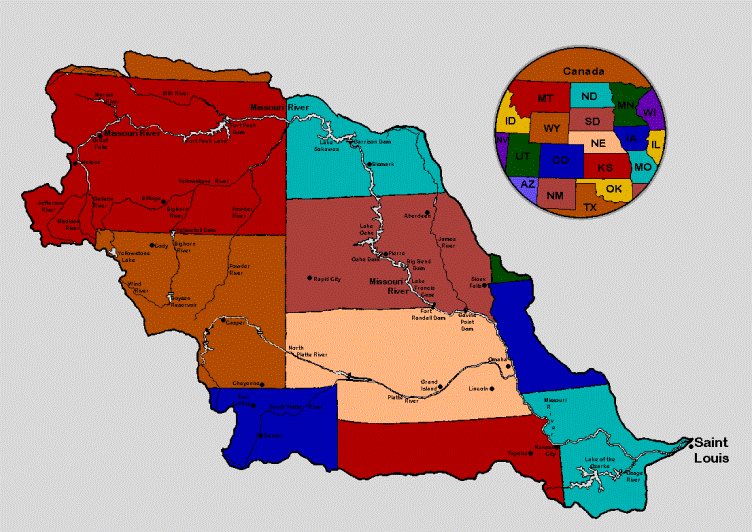

Pilot on the River of Hazards

Steamboat to the Rockies

Steamboat Website Museum
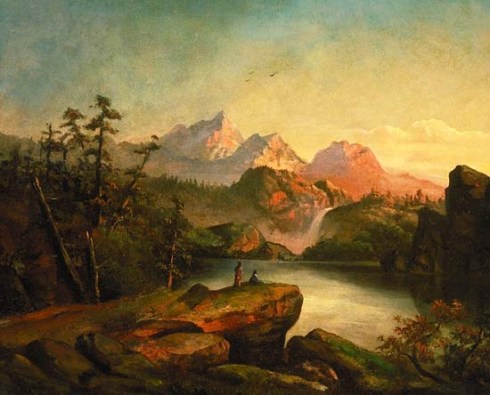
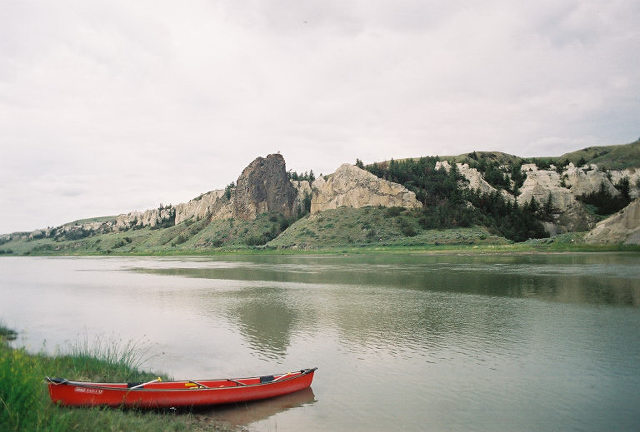
The steamboat is the Desmet, one that was captained by Joseph Labarge. Originally a black and white picture, the foreground was colored in green. The third picture is an antique print that shows the Minarets, a famous landmark along the Missouri. Both the Missouri and the Yellowstone Rivers have their source in Yellowstone Park in the Northwestern corner of Wyoming.

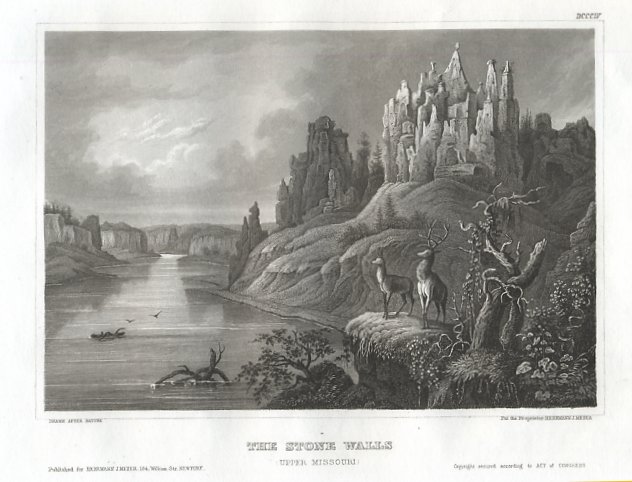
River tours of the three rivers forming the headwaters of the Missouri river in Montana are offered by many outfits along this stretch of the Missouri. Check out this website for pictures of the Missouri.
Three Rivers Canoe Trips
Navigate the Lauck page
| Peter Lauck | Amelia's Quilts | Pierre Lauck - Aerialist | Hold |
|---|
Peter Lauck (1752-1839) and wife Amelia Heiskell (1760-1842)
Peter and Amelia were the great-great grandparents of Pierre LaBarge, whose mother was Louisa Lauck. They are both famous in their own rights. Peter for his Revolutionary War experiences and Amelia for her quilt making.
At this site, you will see portraits of the family painted by the famous artist Jacob Frymire. The paintings are housed at the Corcoran Gallery of Art in Washington, DC. One of his most famous paintings is of Amelia.
The Semon Family
Veronica Semon was born February 25, 1952. She was the third daughter born to Vernon Semon and Rose Resetaritz. On August 17, 1973 she married James Morrison in St. Louis. They have one daughter Lydia.
This is a picture taken at the marriage of Vern Semon and Rose Resetaritz in 1941.
This is a picture taken the summer of 1989 of Veronica Semon, husband Jim Morrison and daughter Lydia. This is a picture of Jim (website host) and Veronica Morrison, with their daughter Lydia. This picture was taken in the winter of 2006 when visiting Lydia in London. Lydia is a senior at the University of Maryland College Park, and was spending a semester abroad in the UK. Rose Resetaritz was born in St. Louis, Missouri on September 10, 1915. Her parents were born in Stinatz, Austria. This is a picture of their wedding party in 1910. Close cousins of Rose still reside in Austria and have been visited by the family over the years. A picture of Franz Zsifkovits and their families follow:
A wonderful website created by Beth Humphrey can be viewed by following the link
Peter Lauck Family
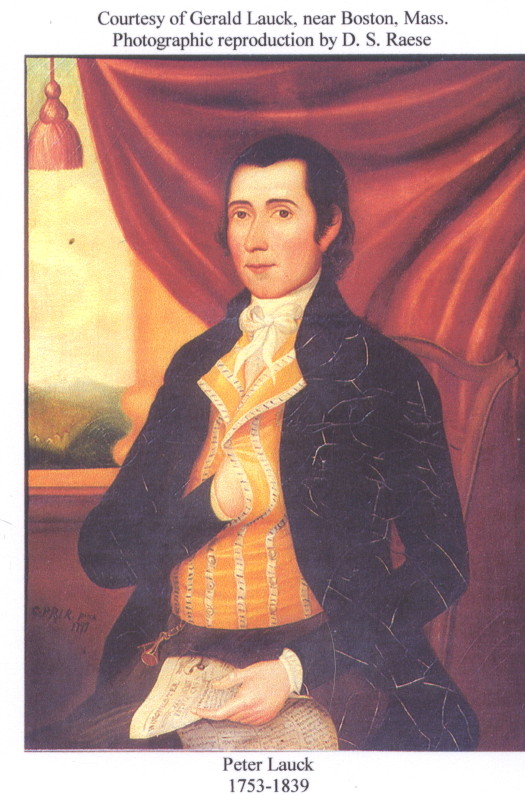
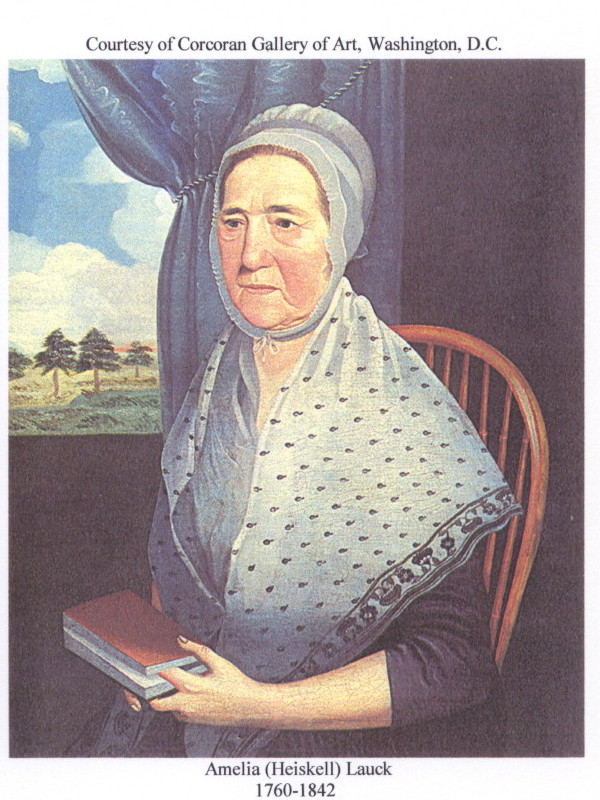
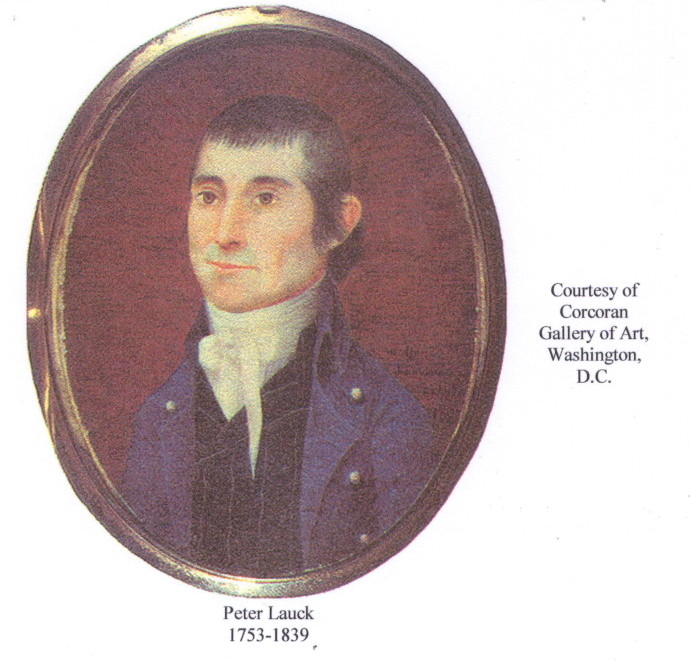
You will also read about the Lauck brothers, Simon and Peter, and their service with the famous rifleman company Morgan's Raiders during Dunmore's War of 1774. They answered Washington's call to arms to Boston, performing the famous "bee line" march. Later they fought in the Battle of Quebec, where Peter was captured. Simon Lauck later became a famous rifle maker, and his guns are today prized collectors items.

Simon probably apprenticed with J.P. Beck during the revolution. Beck's first wife, Anna Maria Lauck, was the daughter of Peter and Amelia. Listed as a gunsmith 1783-1785 in Lebanon Township, Lancaster County, Simon returned to Winchester by 1787 and took on Henry Harding as an apprentice early that year. He trained 2 sons, took on apprentices, employed journeymen, and was a successful businessman.
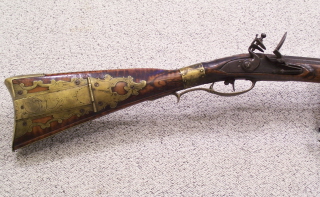
This rifle is his earliest known example produced in Winchester. There are strong Lebanon characteristics, i.e. architecture, trigger guard, and engraving technique. However, Simonís transition to existing design characteristics already established in Winchester are evident. The upper and lower plates of the patchbox, carving and engraving design, and patchbox lid release relate to those used by the Haymakers prior to 1790
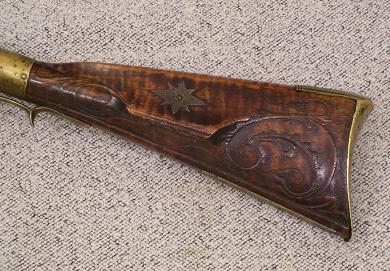
Simon was an excellent carver but never executed in high relief. This design is not too distant from Lebanon but is seen on a rifle by John Haymaker dating to 1785. Rocco styling is evident in the venated wavy line surrounding the C scrolls. This rocaille motif, found on furniture, silver, and other decorative arts in Europe and America, is based on the naturalistic appearance of the edge of a shell. One of Simonís rifles was exhibited/published by Morrison Hecksher and Leslie Greene Bowman in ďAmerican Rocco, 1750-1775Ē.
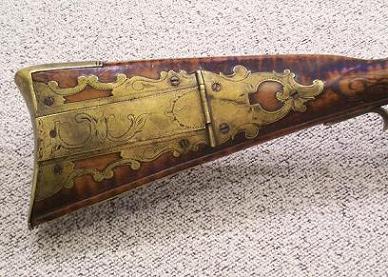
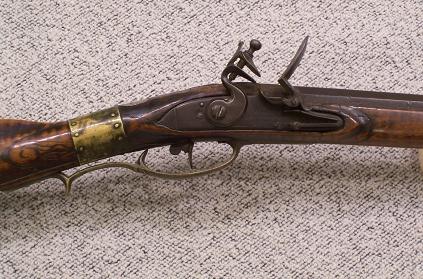
THE BATTLE OF COWPENS, S.C. JANUARY 17, 1781
Cowpens was a brilliantly-led victory by Brigadier General Daniel Morgan with his Valley of Virginia frontiersmen sharpshooters. His strategy of feints and planned withdrawals with his infantry resulted in his entrapment of the British there with his frontier cavalry and infantry, a well-planned and successful strategy.

General Daniel Morgan outgeneraled the British forces at Cowpens led by the Britisher "Bloody" Banastre Tarleton who had theretofore given no mercy to the Americans he defeated and had put to the sword many of those he captured or had defeated who were helpless and unable to defend themselves. He was brutal.
Morgan's Rifle and Cavalry Regiment has been described as the most decorated unit in Washington's army during the Revolution.
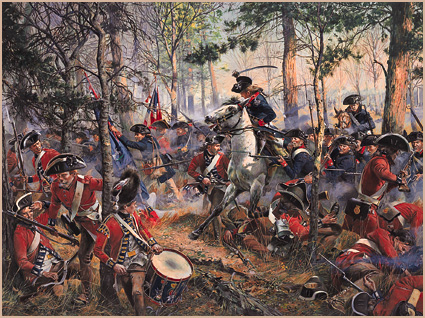
Morgan used his two forces, cavalry and infantry, in brilliant strategy, the riflemen as the point men in the beginning of a battle to draw the enemy's troops towards them, then withdrawing for an ambush by Morgan's cavalrymen who swooped down on the enemy, supported by the infantry who had set up the ambush and then again attacked. Morgan was an old hand with this strategy.
General Daniel Morgan, earlier in The Battle of Saratoga, New York on October 17, 1777, had at the beginning of the battle positioned one of his best sharpshooter snipers in a tree on the battlefield. He described to the sharpshooter how British General Simon Fraser was dressed and told him that when he saw him to take him out of the battle.
The sniper did as Morgan directed, which, together with the ferocity with which Morgan's men fought, contributed to the defeat there of the British in which they captured some 4900 of British soldiers defeated principally by Morgan's men. General Fraser's death by the sniper left the British forces in confusion and Morgan's men attacked.
General Morgan had seen at the defeat of British General Braddock in 1755 how, when the leading general was killed, as Braddock was there, the men were left in disarray. Morgan took advantage of this strategy and repeated it at Saratoga.
These two 1780 and 1781 victories, Kings Mountain and Cowpens, gave a great morale boost and support to Washington's forces in the North. When the British moved north toward them into Virginia, Washington marshaled his forces and those of the French and trapped and defeated British General Cornwallis at Yorktown, the battle which won the War for Independence. in October 1781.
Peter Lauck Huguenot American Hero (1753-1839) by Edna Collins
A fictional book on Peter Lauck was written in 2008 by Edna Collins, a writer and descendant of Peter. While the story is fictional, much of it is based on fact. Note the two pages of the book where it is stated that one of Amelia's quilts sold at Christie's in 2007 for $96,000. The book can be purchased on Amazon.



AMELIA'S QUILTS
The Museum of the Daughters of the Revolution have two of Amelia's quilts, and Alden O'Brien of the museum has described them as the most important pre Civil War quilts of their kind. Amelia made one for each of her children. Two others are in the Williamsburg Museum.

in the summer of 2010, Tom and Jim Morrison visited the DAR musuem where they were met by Alden O'Brien. She graciously brought out William's quilt from their most protected storage. In fact, the box that the quilts are stored in are labeled with instructions to save them first in case of fire. The other historical textile mentioned along with Amelia's quilts are Thomas Jefferson's socks!
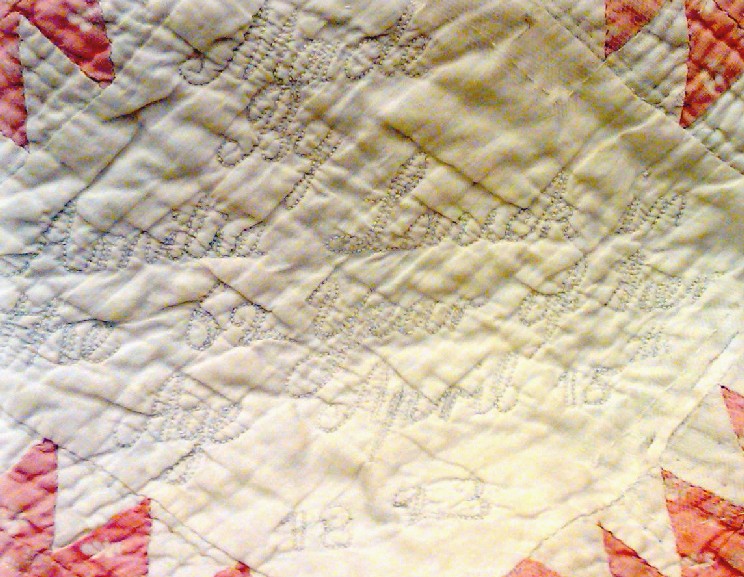
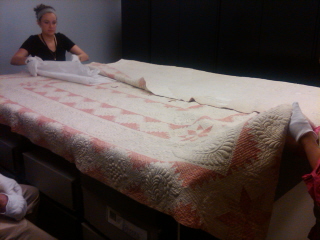
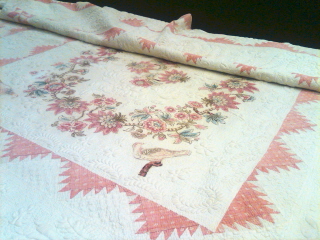
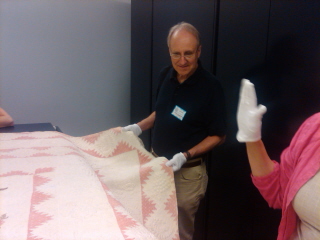
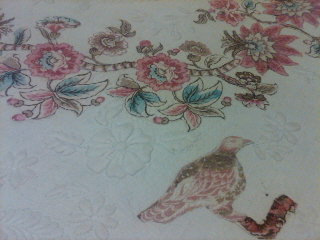
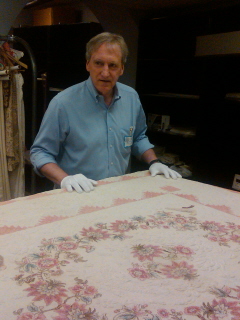
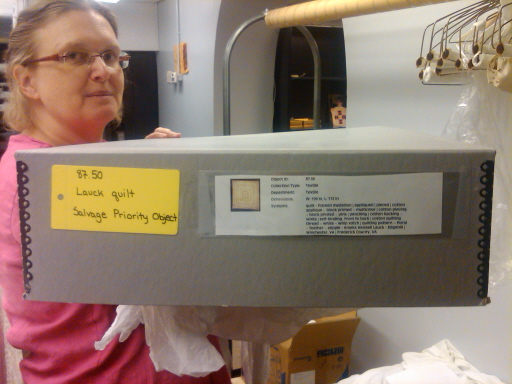
Pierre Lauck - Circus Aerialist of the famous "Lauck & Fox"
Courtesy of our Uncle Gene LaBarge, we have the beginning of the story of Pierre Lauck, brother of Loulou LaBarge, grandmother to Gene, our great grandmother to others. The billing below is one of numerous documents and letters that Gene has and is in the process of compiling at this time. Pierre was a famous aerialist at the birth of the modern circus, and the team of Lauck & Fox are credited with inventing some of the most creative and daring trapeze acts. They traveled extensively throughout Europe between 1870 and 1894. Pierre's career was his life as well as the cause of his death.
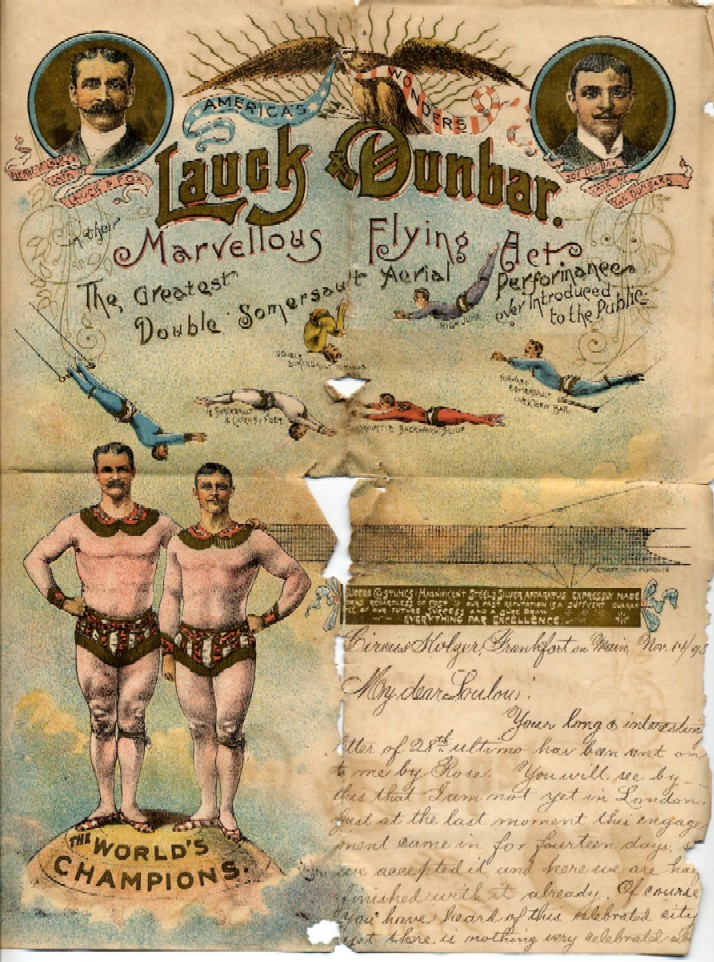
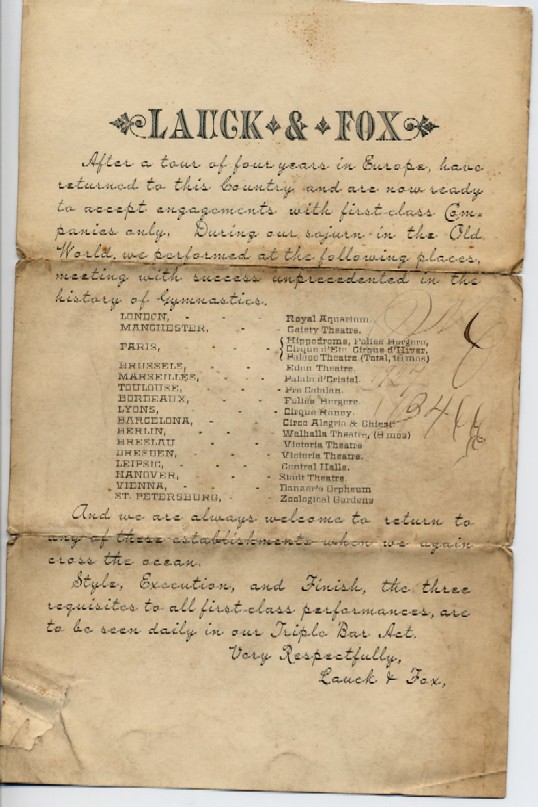
By Pierre Couderc. Bandwagon, Vol. 8, No. 6 (Nov-Dec), 1964, pp. 15-18, 23-24.
"This act which we have just witnessed, with others of varying characters, requires for its execution technical perfection as well as super-physical qualities in the performer beyond that demanded by any and all forms of art; for life and limb are involved as well as pride of professional of artistic accomplishment." - Irving K. Pond
The Three Bars (Les Barres Fixes)
Obviously the above quotation is applicable to all circus performers. But it becomes even more relevant - almost axiomatic - regarding the artists who perform that most difficult and most hazardous branch of acrobatics named: The Three Bars!
It is indeed deplorable that this speciality, which once was considered a standard attraction on all circus programs, has been steadily falling into decadence.
Though still considered by pros and connoisseurs as "the acme" of circus ring artistry, the three bars are seldom seen nowadays. Once upon a time there were literally countless triple bar acts flooding every circus ring here and abroad. Today only a mere handful can be found performing this old acrobatic standard.

Why? What are the reasons for this deplorable decline?
Two of the more obvious factors can be cited:
1. the uninitiated spectator, rarely aware of the intricacies involved in this type of performance, lacks a proper sense of appreciation.
2. the performer, aware of this lack of appreciation, has found it more rewarding to devote himself to much less exigent fields - such as the flying trapezes or teeterboard, either of which always trigger more applause than the best of bar acts.
Perhaps, to a degree, our circus historians and chroniclers can be held accountable for this lack of appreciation from the average spectator. For some strange reason difficult to fathom, most of our circus writers have always devoted a disproportionate amount of space extolling the feats of the flying trapezist, while sadly neglecting those of the barrist who, ironically, is by far the greatest of the two artists. To read more, see this website.
Again, using the same pass as an illustration, a back somersault while passing from the 1st to 3rd bar is also more dangerous than doing it with a "half-twister" - though the latter appears more difficult. The single is more dangerous because if for any reason the performer lacks sufficient height while passing over the 2nd bar, he risks cracking his skull against that 2nd bar. With a "half-twist", the pass becomes somewhat like a long "fly-over", where in instead of catching the 2nd bar, the performer is able to catch the 3rd bar from underneath.
Because of the danger involved in all three types of passes from the 1st to 3rd bar, some performers use a dismountable 2nd bar, which is removed for this particular routine. Again, from the spectator's point of view, this removal of the 2nd bar enhances rather than lessens the effect, for it focuses the spectator's attention to the distance between the two end bars, making it appear more spectacular and seemingly more dangerous.
Our circus historians, past and present, are not in complete accord regarding the origin of the triple bar act. There are some who contend that Lauck & Fox created that speciality back in 1875 - and later were performing it in Paris in 1878. Others claim that the team of Berli, Leach & Foster originated it in England around 1864; while still others credit the Hanlon Bros. for the innovation at some earlier date.
Circus History Website
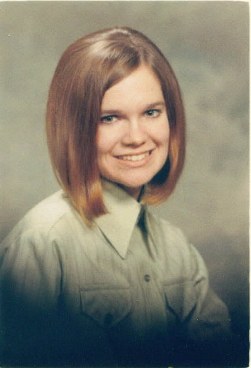
To view the census image of 1930 of Vernon Semon and his parents, click below:
View Semon 1930 US Census image
To view the census image of 1930 of Rose Resetaritz and her parents, click below:
View Resetaritz 1930 US Census image
To view the family tree of the Semon and Resetaritz families of St. Louis Missouri, click here:
View Semon Resetaritz Family Tree
Download Semon Resetaritz Ged File
